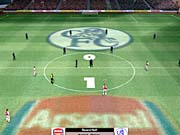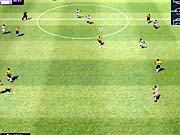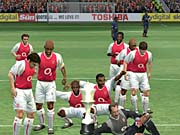As we've seen both in 1998 and this year, EA Sports generally tries to take full advantage of the World Cup, and how much interest it generates in the sport of soccer, by releasing not one, but two soccer games in a year. And now, just five months after 2002 FIFA World Cup comes FIFA Soccer 2003. The latest edition of this decade-old franchise is perhaps the most intriguing in some time, highlighting the tactical battles of the real-life sport and at least partially abstaining from the slam-bang superhuman action of past versions. Make no mistake, the pace can still be inordinately fast unless you choose to slow it down, but this may well be the FIFA that hard-core fans have been waiting for.

Presumably since EA Sports has already covered international competition in its earlier game, 2002 FIFA World Cup, FIFA Soccer 2003 focuses on club competition. However, its scope is absolutely huge, encompassing 450 teams from around the world and more than 10,000 individual players, each modeled after real-life counterpart. You can choose from globally renowned powerhouses such as Real Madrid, North American Major League Soccer teams such as the San Jose Earthquakes, or somewhat less-renowned franchises like Korea's Pusan Icons.
The game also features the complete 40-squad international roster from this year's World Cup competition, more than two-dozen gorgeous and purportedly accurate stadiums, and a full allotment of home and away uniforms (and additional "alternate" kits where applicable) for each and every team. Play modes include one-off skirmishes, league seasons, and authentic and custom cup competitions and tournaments. Skilled players have an opportunity to unlock even more tourneys and stadiums by proving themselves worthy on the pitch.
This time around, EA Sports has opted for a deceptively minimalist user interface that makes it easy for rookies to jump right in without being assaulted by a barrage of information screens and choices, but the interface seems poorly designed for veterans who feel the need to tweak and customize. Furthermore, most menus tend to look comparatively rough, with little of the flash and high-end options you might expect from an EA Sports game. Particularly frustrating are the small arrow-shaped icons used to advance forward and move back; they're difficult to locate and hard to activate once you do see them. It's not a completely minor issue either, because these annoying little arrows are used throughout all of FIFA 2003, even for the in-game menu system.
One interesting amenity that you won't even find in the game but can download free of charge is the official "FIFA creation center," a nifty utility that lets you create new players, customize their physical attributes and soccer skills, concoct new kits with predesigned or personalized artwork, modify competitions, and even construct your own logos and banners. It's certainly great, but it should have been included in the game right out of the box.
But FIFA 2003's most important feature is its increased focus on a realistic playing experience. In that respect, EA has significantly tweaked a number of gameplay elements to reward those who calculate their movements in advance, devise pass-based attacks, and use every single button and button combination at their disposal. It has also devised a game with substantially fewer offside calls, and that's good news for everybody.
In FIFA 2003, you can't always rely on the good old speed-burst option to pull you through. In fact, speed bursts are nothing like they were previously. When you hit the jets, your players will take a moment or two just to get up to speed. They'll also take at least that long to slow down again at the end of the burst, and they'll also have a lot less control over the ball while they're in the process of speeding. To make matters worse, the defender marking your runner will dog him every step of the way, most often closing ground simply because he doesn't have to worry about dribbling a soccer ball. Clearly, the speed burst is much more realistic than it was in previous games.
Scoring a goal in FIFA 2003 is similarly more challenging. You'll no longer pull off amazing on-target blasts by simply touching the shoot button and letting go of your movement key or gamepad. Now, you're forced to point your striker directly at the net and punch the shoot button in precisely the right spot or face a string of missed opportunities. Snapping one wide from even a scant 20 feet out is a distinct possibility. In addition, goaltenders now stray well off their lines to cover the entire penalty area, and they sometimes go beyond. It doesn't help that the game still tends to direct too many shots toward goalposts just to keep the score close, though in FIFA 2003, you'll get less of a sense that the game has decided the final score in advance than in previous games.

FIFA 2003 is certainly a more difficult game to master than its predecessor was. More players touch the ball via deflections, bump passes, blocks, and missed passes, and that calls for quicker reactions and better planning. Even gathering in a high ball on the touchline involves more precision and skill. Fortunately, EA Sports has included a number of complex advanced maneuvers and aids designed for those who want to take the time to master them.
The most obvious of these new features is FIFA's metering system. Though it's used for different purposes in different situations, FIFA 2003's meter works much like the swing meter in a PC golf game; it indicates the velocity or direction of your upcoming pass or shot and ultimately gives you more control over the proceedings. Advanced players will also want to experiment with the game's new freestyle control feature, which, when used properly, coaxes a variety of unique and often thrilling signature moves from star performers.
Yet for all its improvements, FIFA 2003's gameplay is not without a few flaws. The most obvious of these is right in the middle of the game's otherwise impressive AI player behavior. Though computer-controlled players often move intelligently to intercept balls and generally place any part of their anatomy in the path of a shot or pass, defenders not in direct contact with the ball carrier can and will do some mighty strange stuff in certain circumstances. When faced with a speed-bursting ball carrier that is already marked by a teammate, some defenders may stand rooted to the ground, unable to move until trodden over. A similar situation arises when defending against passes. Although defenders will maneuver realistically to intercept or otherwise impede the ball if it comes into their area, perimeter defenders will sometimes remain completely motionless until the pass is completed, rather than jumping in and actively trying to recover the ball.

Something else that may frustrate FIFA purists is the inherent speed of the game. FIFA 2003 does let players adjust the pace of each match independently of the difficulty setting, yet even at the slowest setting matches are perceptibly faster than real world-class soccer matches. The fastest speed is absolutely dizzying. Given that the game already moves slightly quicker as the difficulty level is adjusted upward, and seeing that defenders can reverse directions and sprint faster within their own penalty area, playing a game at the highest difficulty level and at the highest speed settings will make for an unrealistically frantic match.
Visually, FIFA 2003 offers a few new surprises. After a goal, oversized images of the current score and the team logos are superimposed at the center of the pitch. At the end of each half, the game automatically runs a series of scoring and infraction replays. Yet some of the pomp and pageantry EA Sports concocted for the most recent editions of the game is conspicuously absent. Most noticeably, players no longer go bananas or perform bizarre ritualistic dances after scoring a goal. Now, they observe their success in a far more conservative manner that involves lots of fist pumping and arm waving but precious few of the wild celebrations of days gone by.
Only slightly less disappointing are the festivities accompanying a championship triumph. Although teams do get a chance to bring their newfound trophy to the center of the pitch for a few quick glamour photos, there are no victory laps or untamed frivolity. And for some reason, the game's replay option no longer lets you manipulate the camera or zoom in.
Even so, the FIFA series has consistently been one of the finest graphical showcases in the business. EA Sports has dedicated much of its decade-long FIFA efforts to creating a visual spectacle that matches or surpasses any other sports game out there, and it shows. At 1024x768 resolution and with the video setting at "high," FIFA 2003 is colorful, clean, and swarming with details. The 24-plus stadiums look fantastic--each is carefully modeled after a real-life venue and is presented beautifully. You may even want to choose one of the field-level perspectives just to take in the dramatic architecture or watch the exploding fireworks, rotating advertisements, and grandstand partying when the camera inevitably pans upward from the field.
The spectators that fill those grandstands don't always look as good. Although they're portrayed as lively, reactive beings that bounce up and down in unison, wave flags, and toss massive steamers onto the pitch, they are clearly flat, infinitely thin polygons that look like little more than a thin colored line when viewed from the side.
When funneled through a powerful surround system--or even when it isn't--FIFA 2003 sounds spectacular. The spectators respond to the flow of the play in a most dramatic fashion, varying their enthusiasm accordingly by producing an uproar of speaker-crushing volume and depth when the home side pops one home and falling deathly silent when the bad guys score. Moreover, fans of the game's top 18 clubs, as determined by EA Sports, shout specific chants geared for those particular teams. This sense of a real, reactive home crowd has never been so pronounced in any previous edition of FIFA.

Back for a return engagement in the announcer's booth is quintessential soccer broadcaster and FIFA series veteran John Motson. Together with former Scottish football star and FIFA newcomer Ally McCoist, who serves a satisfactory first-time stint as color commentator, Motson is typically brilliant. His verbiage is believable and wide-ranging, and his delivery is impeccable. In fact, the commentary is so seamless that you may sometimes wonder if Motson and McCoist have set up shop inside your computer.
With FIFA 2003, EA Sports has proven it will finally take a few risks by varying the formula behind the world's number one soccer game. In so doing, it has produced a considerably more challenging and complex affair that should stand the test of time better than its predecessors. It isn't quite perfect, but the latest FIFA game is a refreshing and compelling step ahead in a series that's known for its quality.